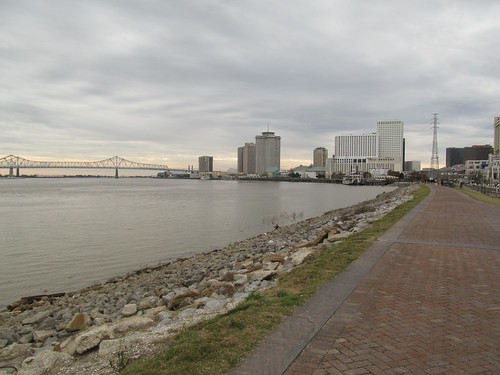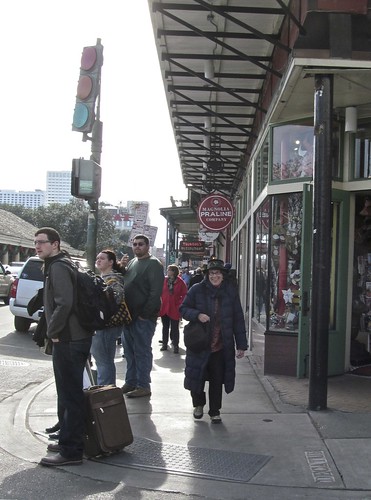The Sunset Limited (4)
Friday December 27, 2013
Though optimally located in the center of the French quarter, Jan and I are uncertain of what we should do for the day. Roaming its tourist-crammed streets yet another time is getting old. We think of taking one of the carriage tours recommended by friends but are put off by the drivers and prices. Instead we sign up for a two-hour full city bus tour beginning at 2:00 p.m.
To make use of the time before then without extensive walking, we take the streetcar along the levee to the river ferry terminal. Probably due to its major diversion by dams upriver, the Mississippi isn’t as impressive here as we’d expected.

But on the ride across, the sight of a tug maneuvering a huge barge through the current at the crescent curve which accounts for the City’s original location gives a sense of being at the drain point of a whole continent.


Following a suggestion in The Unfathomable City, we pick historic Mandina’s Restaurant as a destination for lunch. It’s another gratifying streetcar ride to an outlying district, partly through a vast construction site of new medical facilities. The restaurant is located in a charming old frame house and packed with animated locals, but the supposedly distinctive Italian-Creole food is not worth the cost or the long wait.
The streetcar back is delayed by traffic jams and we are concerned that we will miss our tour. I run ahead to reach the meeting point just in the nick of time, and the dispatcher tells me the bus is late but will wait for Jan. I’m relieved to see her shouldering her way through the crowd before it arrives, but then it turns out to be an hour late.

Sipping Vodka daiquiris from the adjoining dispensary relieves our impatience, but most of the other waiting passengers ask for their money back and leave. The apologetic young man who finally shows up explains that the delay was caused by unexpected traffic congestion and the dispatcher’s mistakes. He offers little information about the city sights we pass, but stirring stories about his family’s escape from the flooding and his sister’s permanent mental derangement resulting from it. Only when he stops behind another tour bus outside a cemetery in the Ninth Ward do we learn that he’s just a driver delivering us to the guide and the rest of the group.
By this time the confusion of the delays combined with the effects of the daiquiri have rendered us receptive to whatever happens next. The real guide, whose name I regret not learning, is a round, white-haired gentleman with a sonorous voice and a preacherly eloquence.

He regales us with the some of the peculiarities of NOLA’s necropolis culture, among them that bodies cannot be buried but are housed in weighted above-ground tombs to accommodate flooding and that crypts are continually recycled because the summer heat quickly decomposes earlier remains.
Sinking into the driver’s seat as if it were a bathtub, he drives us through the adjoining neighborhood, pointing out the modest homes of legendary musicians like Fats Domino and the Marsalis brothers, all of whom he knows personally, and tells us that the government was interested in reconstructing this district after the failure of the ship canal dykes because its artists form an important part of the economy. He assures us that contrary to earlier occasions when dykes around low-income areas were deliberately breached to protect the precincts of the wealthy, the worst destruction of Katrina was caused merely by the negligence of the Army Corps of Engineers.
The onset of dark and the heavily tinted windows of the bus make it impossible to see or photograph the features of the city through which he drives us for the next two hours. But he’s a good enough story teller to keep the tour group engaged and laughing.
Many of the district’s modest houses have been refurbished by Habitat for Humanity and lifted three feet off the ground on cinder block piers. Some remain dilapidated and some lots are cleared while owners wait for property values to rise. Many are only about ten feet wide. At first I think they were former slave quarters, but then see that they extend far toward the back of the lot. Called Creole Cottages or Shotgun houses, we learn they were designed like this before the advent of fans or air conditioning to promote cross ventilation in the unbearable summer heat.
We hear of the development of the different faubourgs or neighborhoods by ingenious and often scandalous land developers over two centuries, the division of the city into downriver Creole and upriver “American” districts, the unceasing corruption of city politicians, many of whom go directly from office to jail, about universities and private schools and mardi-gras parade routes and the demolition of sections of the French Quarter replaced by disastrous city housing projects, of the outrageous number of annual murders, of the benefits and losses of gentrification since Katrina, and about the architectural styles and residents’ private lives of countless houses.
We’re dropped off in another traffic jam a block from our hotel, the city now packed with New Year’s eve visitors arriving as we prepare to leave. Thrashed by our colds, we retreat to our hotel, again forgoing the chance to taste the nightlife and the music, but inspired enough by the surroundings to seek more alcoholic relief. A big bouncer at a strip joint on Bourbon Street informs me that the best place to buy a bottle is the CVS around the corner. Hurrying back to our room with my paper bag through the earsplitting noise of revelers, I feel as excited as any of them.
For more and full-size pictures, click here
